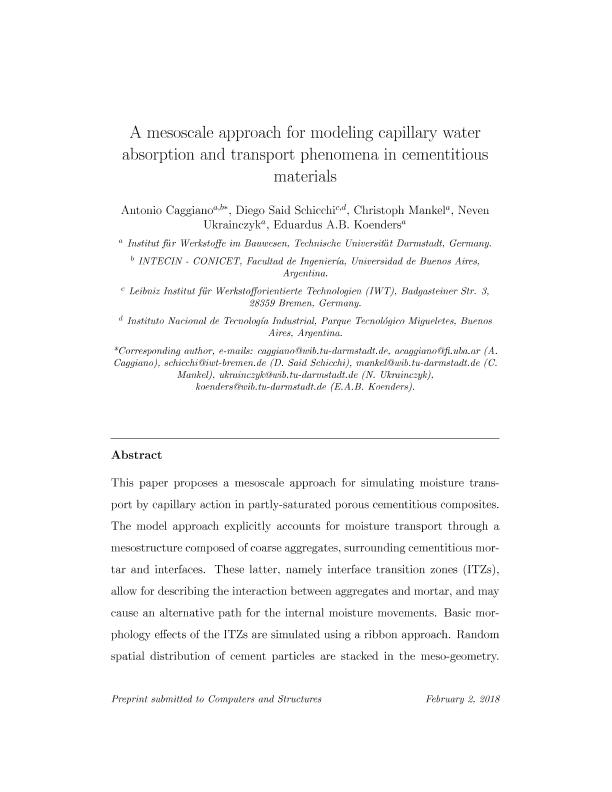Mostrar el registro sencillo del ítem
dc.contributor.author
Caggiano, Antonio

dc.contributor.author
Said Schicchi, Diego
dc.contributor.author
Mankel, Christoph
dc.contributor.author
Ukrainczyk, Neven
dc.contributor.author
Koenders, Eduardus A. B.
dc.date.available
2019-11-05T21:20:08Z
dc.date.issued
2018-04
dc.identifier.citation
Caggiano, Antonio; Said Schicchi, Diego; Mankel, Christoph; Ukrainczyk, Neven; Koenders, Eduardus A. B.; A mesoscale approach for modeling capillary water absorption and transport phenomena in cementitious materials; Pergamon-Elsevier Science Ltd; Computers & Structures; 200; 4-2018; 1-10
dc.identifier.issn
0045-7949
dc.identifier.uri
http://hdl.handle.net/11336/88101
dc.description.abstract
This paper proposes a mesoscale approach for simulating moisture transport by capillary action in partly-saturated porous cementitious composites. The modeling approach explicitly accounts for moisture transport through a mesostructure composed of coarse aggregates, surrounding cementitious mortar and interfaces. These latter, namely interface transition zones (ITZs), allow to describe the interaction between aggregates and mortar, and may cause an alternative path for the internal moisture movements. Basic morphology effects of the ITZs are simulated using a ribbon approach. Random spatial distribution of cement particles are stacked in the meso-geometry. Aggregate particles are introduced as randomly perturbed polygons and the moisture transport is modeled as a diffusion problem and solved by means of the finite element method. The proposed constitutive models are based on a proper description of the permeability and pore size distribution which strongly affect the local moisture content. Numerical results at both macro- and mesoscale levels demonstrate the soundness and capability of the proposed approach. The integrated modeling results actually demonstrate the potential of the mesoscale approach and shows the role of the ITZs as an internal interconnected network.
dc.format
application/pdf
dc.language.iso
eng
dc.publisher
Pergamon-Elsevier Science Ltd

dc.rights
info:eu-repo/semantics/openAccess
dc.rights.uri
https://creativecommons.org/licenses/by-nc-sa/2.5/ar/
dc.subject
Capillary water absorption
dc.subject
Moisture transport
dc.subject
Partly-saturated porous concrete
dc.subject
Mesoscale
dc.subject
Diffusion problems
dc.subject.classification
Ingeniería Civil

dc.subject.classification
Ingeniería Civil

dc.subject.classification
INGENIERÍAS Y TECNOLOGÍAS

dc.title
A mesoscale approach for modeling capillary water absorption and transport phenomena in cementitious materials
dc.type
info:eu-repo/semantics/article
dc.type
info:ar-repo/semantics/artículo
dc.type
info:eu-repo/semantics/publishedVersion
dc.date.updated
2019-10-22T15:04:51Z
dc.journal.volume
200
dc.journal.pagination
1-10
dc.journal.pais
Países Bajos

dc.journal.ciudad
Amsterdam
dc.description.fil
Fil: Caggiano, Antonio. Universitat Technische Darmstadt; Alemania. Consejo Nacional de Investigaciones Científicas y Técnicas. Oficina de Coordinación Administrativa Houssay. Instituto de Tecnologías y Ciencias de la Ingeniería "Hilario Fernández Long". Universidad de Buenos Aires. Facultad de Ingeniería. Instituto de Tecnologías y Ciencias de la Ingeniería "Hilario Fernández Long"; Argentina
dc.description.fil
Fil: Said Schicchi, Diego. Leibniz-Institut Für Werkstofforientierte Technologien; Alemania. Instituto Nacional de Tecnología Industrial; Argentina
dc.description.fil
Fil: Mankel, Christoph. Universitat Technische Darmstadt; Alemania
dc.description.fil
Fil: Ukrainczyk, Neven. Universitat Technische Darmstadt; Alemania
dc.description.fil
Fil: Koenders, Eduardus A. B.. Universitat Technische Darmstadt; Alemania
dc.journal.title
Computers & Structures

dc.relation.alternativeid
info:eu-repo/semantics/altIdentifier/url/https://www.sciencedirect.com/science/article/pii/S0045794917306922
dc.relation.alternativeid
info:eu-repo/semantics/altIdentifier/doi/http://dx.doi.org/10.1016/j.compstruc.2018.01.013
Archivos asociados
